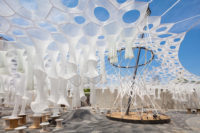It’s been a busy May for Shohei Shigematsu and OMA New York. Earlier in the month, the OMA-designed renovation of Sotheby's New York headquarters opened to the public. Just last week, the firm’s exhibition design for Dior: From Paris to the World, opened at the Dallas Museum of Art, and OMA was named the winner of the competition for the University of Illinois at Chicago’s Center for the Arts. Today, OMA’s first ground-up project in New York City—a residential complex in Manhattan’s Gramercy Park neighborhood—is officially complete.
The new development, 121 East 22nd Street, comprises two towers, the taller of which marks its presence at the intersection of East 23rd Street and Lexington Avenue with its facade of charcoal-colored precast concrete panels and a glazed, faceted corner that reflects passersby, traffic, and the surrounding buildings at multiple angles.
The residence’s main entrance—at the smaller, south tower—is tucked into a melange of historic residential buildings along the quieter East 22nd street, which includes an early twentieth-century C.B.J. Snyder-designed school. Shigematsu took inspiration from the surrounding structures for the fenestration: at the north tower, the inset windows are arranged in a gradient, reflecting the narrow apertures of adjacent buildings at the ends and getting wider as they approach the corner; the south tower’s refracted window grid has a more subtle expression.
The 18-story and 13-story towers are connected on the L-shaped site via a shared courtyard, which is wrapped with amenities, including a pool, gym, and automated parking (whose moving cars are visible from the courtyard through translucent glass panels). Rather than have terraces face the busy streets, Shigematsu arranged them to open out to this quiet outdoor space—what he refers to as the “valley”; each of the balconies takes a different angular form, echoing the north tower’s dynamic corner condition.
Located at the crossroads of busy city streets and the private residential area anchored by Gramercy Park, the new development “reflects a split-personality,” says Shigematsu, managing to respect the surrounding context while creating a unique and contemporary identity.









